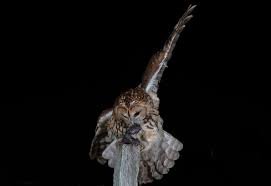An owl’s diet may include anything from rodents and insects to small mammals and even other owls. The fast rate of metabolism in owls necessitates that they consume food equal to as much as half their body weight every day.
Behavior and Physiology of Owls

A lot rides on the owl’s species and how it lives, thus estimating its longevity is a futile exercise. Captive owls, on average, outlive their wild counterparts by several years. A wild owl can expect to live for about 10 years, but a captive owl that is cared for by humans can expect to live for over 20 years. Many species of owl are strictly nocturnal, meaning they only come out at night to hunt and eat. However, only a small percentage of species are diurnal, or activities throughout the day. The daily feeding needs of owls are rather consistent, ranging from about 3 to 4 ounces (85 to 113 g) of food on average.
For instance, smaller owls have a higher caloric need than larger species due to a higher metabolic rate. A negative side effect of this is the reduced food requirements.
Owls Cannot Chew

Birds of prey like owls, which share this trait with other birds, lack the teeth necessary to properly chew their meal. In order to kill their prey, they use their hooked bills to tear apart their flesh and sometimes even crush their skulls and other bones. In addition, they can gulp down small prey whole, typically in a head-first position. When owls eat, they swallow everything, but the bones and fur, which they regurgitate as a pellet a few hours later.
What do owls eat?

Each species of owl has a unique diet that’s affected by factors like the weather patterns in its natural environment and its location on the map. They are all carnivores, although their specific diets vary depending on what they can find in their natural habitat. Owls may occasionally consume dead animals, but the majority of their diet consists of the prey they capture and kill themselves. Some of these birds specialize in fishing, while others eat anything from insects to small mammals to other birds.
Screech Owls, for example, subsist primarily on insects. A Screech Owl can be either an eastern or western kind. In addition to consuming many different types of arthropods, the western screech owl also consumes slugs, snails, amphibians, fish, birds, and rodents. They feed on crayfish and gigantic carpenter ants in Seattle, but in Arizona, they go after animals.

The mice, voles, and shrews make up the majority of a Barn Owl’s diet. The Eagle Owl, which is larger than the average owl, preys on juvenile foxes, hares, and even ducks and game birds. Desert owls, like the Great Horned Owl, prey on small mammals, birds, and reptiles.
There have been cases of owls stealing small pets like cats and dogs, only to dump them from a great height. One owl species, called the Striped Owl or Hoot Owl, was spotted with a cat on its back. There have been reports of Great Horned Owls attacking cats and small dogs. Fish-eating owls will hover over bodies of water until they spot a meal. Then, without hesitation, they will seize them.
Where do owls and other night-time birds get their food?

Rather than passively waiting for food, owls actively seek it out. In general, owls are nocturnal, or active at night, although the northern hawk-owl and the burrowing owl are exceptions. Those who make their homes in arid regions or other environments with plenty of covers typically hunt by swooping down on their prey and snatching it with their beaks or sharp talons and powerful feet (in the case of insects). In order to kill prey, they take it to a tree and use their hooked, pointed beak, which delivers crushing strength, to pierce and shred the animal’s flesh. Owls normally hunt by swooping down to the ground to catch prey or by swooping down from a perch to capture it.
Also, know Are owls dangerous to humans?
How does an owl digest its meal?

Unlike other birds, owls are unable to chew their food. Their hunting method is either tearing their prey into smaller pieces or swallowing it whole. They have no digestive system, despite being able to ingest bones, teeth, hair, and feathers. Indigestible substances are expelled in the form of pellets, which the animals then re-chew and vomit out. There are owl species that only partially pluck their feathery prey.
Do Owls Eat Dirt?
The population of tiny animals, rodents, reptiles, and birds is kept under check by birds of prey, as you may already know. They usually capture an animal while it is still alive, kill it, and then consume it. When feeding, those birds hardly ever pick at their food or eat any dirt, sand, or leftovers.
Sadly, they often unknowingly consume microfibers and microplastic pieces. It has been calculated that a single owl can consume hundreds of pieces of polyester, nylon, and polypropylene in a single day.
According to one study, microfibers from synthetic clothing and ropes make up 86% of all the plastics ingested by owls and other birds of prey. They frequently make their way out of washing machines and into the wild.
Food Avoid To Feed Owls

You shouldn’t ever give an owl these things when you try to feed it:
- Damage to your owl’s health can be caused by wild rats due to the widespread use of rodenticides. Moreover, these creatures frequently spread Weil’s illness (leptospirosis).
- Pigeons – These birds can spread a wide variety of avian diseases to your owl.
- Cut up a rabbit before giving it to the owl. Shorter owls can be hurt by long, sharp bone shards.





